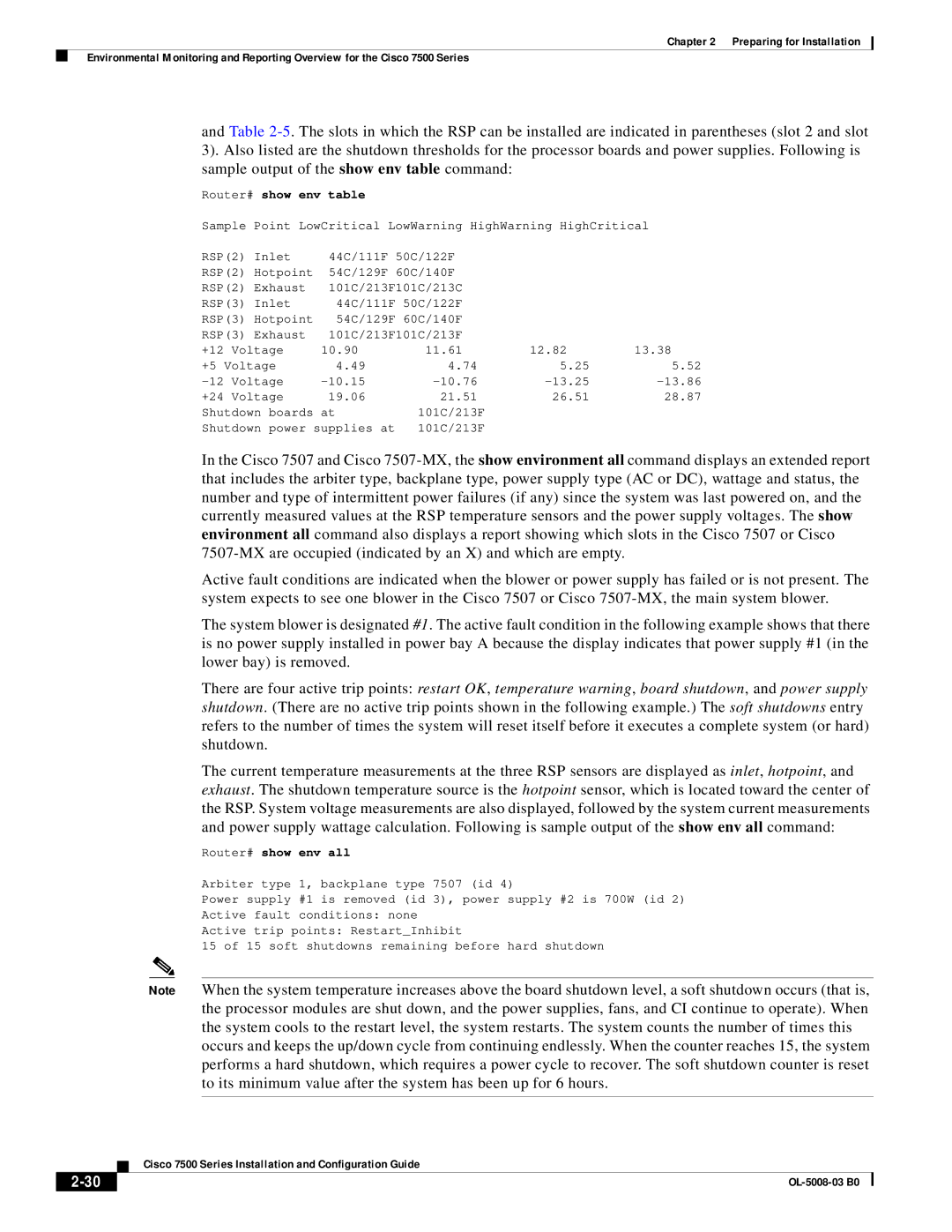
Chapter 2 Preparing for Installation
Environmental Monitoring and Reporting Overview for the Cisco 7500 Series
and Table
3). Also listed are the shutdown thresholds for the processor boards and power supplies. Following is sample output of the show env table command:
Router# show env table
Sample Point LowCritical LowWarning HighWarning HighCritical
RSP(2) Inlet | 44C/111F 50C/122F |
|
| |
RSP(2) Hotpoint | 54C/129F 60C/140F |
|
| |
RSP(2) Exhaust | 101C/213F101C/213C |
|
| |
RSP(3) Inlet | 44C/111F 50C/122F |
|
| |
RSP(3) Hotpoint | 54C/129F 60C/140F |
|
| |
RSP(3) Exhaust | 101C/213F101C/213F |
|
| |
+12 Voltage | 10.90 | 11.61 | 12.82 | 13.38 |
+5 Voltage | 4.49 | 4.74 | 5.25 | 5.52 | ||
Voltage | ||||||
+24 | Voltage | 19.06 | 21.51 | 26.51 | 28.87 | |
Shutdown | boards at | 101C/213F |
|
| ||
Shutdown | power supplies at | 101C/213F |
|
| ||
In the Cisco 7507 and Cisco
Active fault conditions are indicated when the blower or power supply has failed or is not present. The system expects to see one blower in the Cisco 7507 or Cisco
The system blower is designated #1. The active fault condition in the following example shows that there is no power supply installed in power bay A because the display indicates that power supply #1 (in the lower bay) is removed.
There are four active trip points: restart OK, temperature warning, board shutdown, and power supply shutdown. (There are no active trip points shown in the following example.) The soft shutdowns entry refers to the number of times the system will reset itself before it executes a complete system (or hard) shutdown.
The current temperature measurements at the three RSP sensors are displayed as inlet, hotpoint, and exhaust. The shutdown temperature source is the hotpoint sensor, which is located toward the center of the RSP. System voltage measurements are also displayed, followed by the system current measurements and power supply wattage calculation. Following is sample output of the show env all command:
Router# show env all
Arbiter type 1, backplane type 7507 (id 4)
Power supply #1 is removed (id 3), power supply #2 is 700W (id 2)
Active fault conditions: none
Active trip points: Restart_Inhibit
15 of 15 soft shutdowns remaining before hard shutdown
Note When the system temperature increases above the board shutdown level, a soft shutdown occurs (that is, the processor modules are shut down, and the power supplies, fans, and CI continue to operate). When the system cools to the restart level, the system restarts. The system counts the number of times this occurs and keeps the up/down cycle from continuing endlessly. When the counter reaches 15, the system performs a hard shutdown, which requires a power cycle to recover. The soft shutdown counter is reset to its minimum value after the system has been up for 6 hours.
| Cisco 7500 Series Installation and Configuration Guide |
